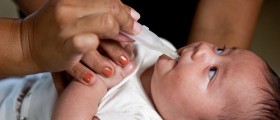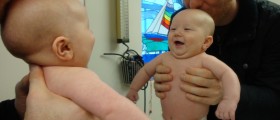
Infection with rotavirus causes mild to severe gastrointestinal upset accompanied with vomiting, diarrhea and low-grade fever. It takes about two days before the infected child shows first signs of infection. The child will probably first vomit, and get diarrhea in a couple of hours. It is important to keep the child well hydrated since rotavirus causes a lot of dehydration, which makes it the common cause of death related this infection.Transmission and prevention of rotavirus
Rotavirus is always spread by the fecal-oral route. This means that contaminated hands, surfaces and objects having rotavirus, present a high risk of infection. Feces of an infected person are highly contagious and just one gram of this matter may have more than 10 trillion infectious particles. However, just 10 to 100 infectious particles are enough to make someone sick. Nevertheless, basic sanitary measures can be effective in control of this virus.
People should always wash their hands often, especially after using the toilet. However, the virus may survive even the most strict hand washing and therefore the primary source of prevention remains vaccination. There are two vaccines that are safe and effective in children. Both are taken orally and contain attenuated live virus. This way, the child’s body will get in contact with controlled quantities of infectious agents, and will be able to form its own immune protection by creating antibodies.
First available vaccine is suitable only for younger children. It is given in three doses usually at ages 2 months, 4 months and 6 months.The second vaccine is a liquid one, given in two doses to infants aged 2 months and 4 months.
There was also a similar vaccine available a couple of years ago, but it was pulled from the market in 1999 because it was shown to increase the risk of intussusception.


_f_280x120.jpg)














Your thoughts on this
Loading...